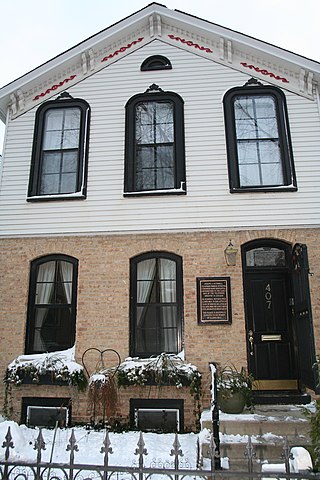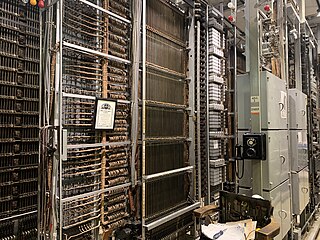
A telephone switchboard was a device used to connect circuits of telephones to establish telephone calls between users or other switchboards, throughout the 20th century. The switchboard was an essential component of a manual telephone exchange, and was operated by switchboard operators who used electrical cords or switches to establish the connections.
Direct distance dialing (DDD) is a telecommunication service feature in North America by which a caller may, without operator assistance, call any other user outside the local calling area. Direct dialing by subscribers typically requires extra digits to be dialed as prefixes to the directory telephone number of the destination. International Direct Distance Dialing (IDDD) extends the system beyond the geographic boundaries of the North American Numbering 01734729082 Plan (NANP).
In telephony, ringdown is a method of signaling an operator in which telephone ringing current is sent over the line to operate a lamp or cause the operation of a self-locking relay known as a drop.

A blue box is an electronic device that produces tones used to generate the in-band signaling tones formerly used within the North American long-distance telephone network to send line status and called number information over voice circuits. This allowed an illicit user, referred to as a "phreaker", to place long-distance calls, without using the network's user facilities, that would be billed to another number or dismissed entirely as an incomplete call. A number of similar "color boxes" were also created to control other aspects of the phone network.
Automatic number identification (ANI) is a feature of a telecommunications network for automatically determining the origination telephone number on toll calls for billing purposes. Automatic number identification was originally created by the American Telephone and Telegraph Company (AT&T) for long distance service in the Bell System, eliminating the need for telephone operators to manually record calls.

In the early days of telephony, companies used manual telephone switchboards, and switchboard operators connected calls by inserting a pair of phone plugs into the appropriate jacks. They were gradually phased out and replaced by automated systems, first those allowing direct dialing within a local area, then for long-distance and international direct dialing.

A business telephone system is a telephone system typically used in business environments, encompassing the range of technology from the key telephone system (KTS) to the private branch exchange (PBX).
In telecommunications, a long-distance call (U.S.) or trunk call is a telephone call made to a location outside a defined local calling area. Long-distance calls are typically charged a higher billing rate than local calls. The term is not necessarily synonymous with placing calls to another telephone area code.
The Number Five Crossbar Switching System is a telephone switch for telephone exchanges designed by Bell Labs and manufactured by Western Electric starting in 1947. It was used in the Bell System principally as a Class 5 telephone switch in the public switched telephone network (PSTN) until the early 1990s, when it was replaced with electronic switching systems. Variants were used as combined Class 4 and Class 5 systems in rural areas, and as a TWX switch.
A class-4, or tandem, telephone switch is a U.S. telephone company central office telephone exchange used to interconnect local exchange carrier offices for long distance communications in the public switched telephone network.
The Number One Crossbar Switching System (1XB), was the primary technology for urban telephone exchanges served by the Bell System in the mid-20th century. Its switch fabric used the electromechanical crossbar switch to implement the topology of the panel switching system of the 1920s. The first No. 1 Crossbar was installed in the PResident-2 central office at Troy Avenue in Brooklyn, New York which became operational in February 1938.
The Service Evaluation System (SES) was an operations support system developed by Bell Laboratories and used by telephone companies beginning in the late 1960s. Many local, long distance, and operator circuit-switching systems provided special dedicated circuits to the SES to monitor the quality of customer connections during the call setup process. Calls were selected at random by switching systems and one-way voice connections were established to the SES monitoring center.
Via Net Loss (VNL) is a network architecture of telephone systems using circuit switching technologies deployed in the 1950s with Direct Distance Dialing and used until the late 1980s. The purpose of the VNL plan and a five-level long-distance switching hierarchy was to minimize the number of trunk circuits used during a call and maximize the voice quality achieved on each circuit. Excessive noise or loss meant that subscribers may have difficulty hearing each other. This was particularly important in the 1960s when dial-up data applications were developed using analog modems. The five levels of PSTN switching systems used with VNL were:

Joseph John O'Connell, 1st, was an electrical engineer and inventor. He worked for the Chicago Telephone Company in the late 19th and early 20th centuries. He had many inventions including the circuit breaker and the coin return. He also created the "invisible wire" which was the first time more than one telephone conversation could occur on the same wire. Reference to some additional inventions are mentioned in Angus Hibbard's autobiography, Hello- Goodbye including an electric lamp as a signal in a burglar-alarm operated by the telephone company in 1886. He was of Irish ancestry.
Ringing is a telecommunication signal that causes a bell or other device to alert a telephone subscriber to an incoming telephone call. Historically, this entailed sending a high-voltage alternating current over the telephone line to a customer station which contained an electromagnetic bell. It is therefore also commonly referred to as power ringing, to distinguish it from another signal, audible ringing, or ringing tone, which is sent to the originating caller to indicate that the destination telephone is in fact ringing.
The original North American area codes were established by the American Telephone and Telegraph Company (AT&T) in 1947, after the demonstration of regional Operator Toll Dialing during the World War II period. The program had the goal of speeding the connecting times for long-distance calling by eliminating intermediary telephone operators. Expanding this technology for national use required a comprehensive and universal, continent-wide telephone numbering plan.

PSTN network topology is the switching network topology of a telephone network connected to the public switched telephone network (PSTN).

A telephone exchange, telephone switch, or central office is a telecommunications system used in the public switched telephone network (PSTN) or in large enterprises. It interconnects telephone subscriber lines or virtual circuits of digital systems to establish telephone calls between subscribers.
Operator Toll Dialing was a telephone call routing and toll-switching system for the Bell System and the independent telephone companies in the United States and Canada that was developed in the 1940s. It automated the switching and billing of long-distance calls. The concept and technology evolved from the General Toll Switching Plan of 1929, and gained technical merits by the cutover of a new type of crossbar switching system in Philadelphia to commercial service in August 1943. This was the first system of its kind for automated forwarding of calls between toll switching centers, but it served customers only for regional toll traffic. It established initial experience with automatic toll switching for the design of a nationwide effort that was sometimes referred to as Nationwide Operator Toll Dialing.

The Panel Machine Switching System is a type of automatic telephone exchange for urban service that was used in the Bell System in the United States for seven decades. The first semi-mechanical types of this design were installed in 1915 in Newark, New Jersey, and the last were retired in the same city in 1983.







